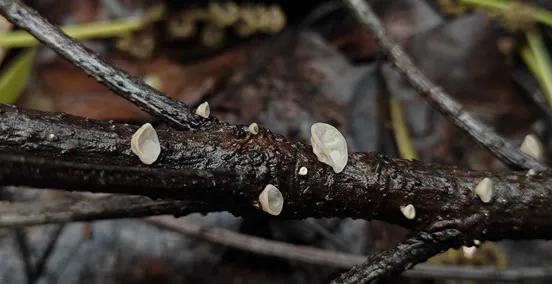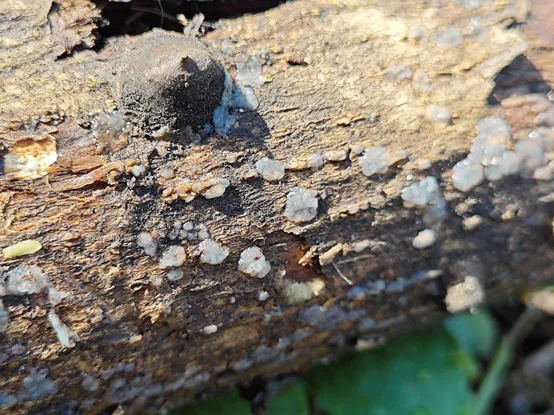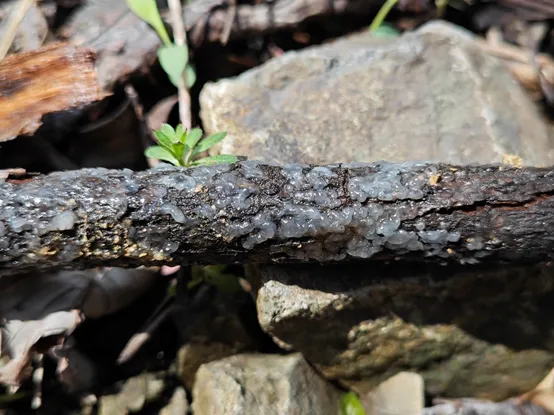

Date issued:2024-03-29
New Global Species Discovered in Biodiversity Survey and Assessment Project Led by CAEP
From 2022 to 2023, the Center for Biodiversity and Nature Reserve of CAEP (hereinafter referred to as "CBNR") led a collaborative project with Beijing Forestry University and the Institute of Zoology, Chinese Academy of Sciences, among other institutions, to conduct a biodiversity conservation and survey assessment project for 12 taxonomic groups across 8 districts in Hangzhou City, Zhejiang Province. During the large fungi diversity survey, two new global species were discovered: Physalacria tianzhongshanensis A. Tohtirjap, L.R. Zhang & F. Wu, sp. nov. and Helicogloea hangzhouensis F. Wu, L.R. Zhang & A. Tohtirjap, sp. nov. These were jointly published by Dr. Lirong Zhang , Executive Director of CBNR, and Dr. Fang Wu from Beijing Forestry University in the international authoritative journal "Mycology." Large fungi are an integral part of ecosystems and play a significant role in maintaining ecosystem diversity and stability.
1.Physalacria tianzhongshanensis
Physalacria tianzhongshanensis belongs to the Physalacriaceae family under the Agaricales order. It is a small, cup- or dish-shaped fungus without a stipe, with a diameter of up to about 1 cm. It is a soft, leathery large fungus, white to cream-colored when fresh. This species resembles a wine glass in shape and was named "Physalacria tianzhongshanensis" because it was first discovered on Tianzhong Mountain in Fuyang District, Hangzhou City. It mainly grows on dead branches of broadleaf trees. In forest ecosystems, dead branches and wood are an essential component, providing habitat for various organisms and contributing to nutrient cycling and the storage of carbon and water. Fungi growing on dead branches and wood accelerate wood decomposition, realizing material cycling in the ecosystem, and their presence is crucial for the surrounding ecosystem. The new species of Physalacria tianzhongshanensis was officially published in the international authoritative journal "Mycology" on March 21, 2024.

2.Helicogloea hangzhouensis
Helicogloea hangzhouensis belongs to the Helotiales order, Helotaceae family, and is a gelatinous fungus that typically grows only when the air humidity is very high during rainy days. Its fruiting bodies are small and difficult to detect, with individual fruiting bodies measuring only 2–4 mm, often aggregated together. Fresh specimens are transparent to white with a smooth surface. Helicogloea hangzhouensis grows adhered to the surfaces of dead branches on trees. It was named "Helicogloea hangzhouensis" because it was first discovered in Xiaoshan District, Hangzhou City, thus Hangzhou has a gelatinous fungal species named after it.


Helicogloea is a parasitic fungus that grows on the decaying wood and fallen branches of broadleaf trees. There are currently 36 known species in this genus worldwide, and Helicogloea hangzhouensis is the first species in this genus found to form fruiting bodies in China. The new species of Helicogloea hangzhouensis was officially published in the international authoritative journal "Mycology" on March 21, 2024.
Biodiversity surveys and assessments are foundational work for biodiversity conservation. Through these activities, the current status of regional biodiversity can be understood, trends in biodiversity dynamics can be monitored in a timely manner, threats to biodiversity can be fully identified, and strong technical support can be provided for regional biodiversity conservation and sustainable use. In recent years, CAEP has carried out biodiversity surveys and assessments in various locations, including Beijing City, Zhejiang Province, and Anhui Province. The biodiversity survey and assessment work in eight districts of Hangzhou City is an effective practice to promote the implementation of the "Kunming-Montreal Global Biodiversity Framework" and the "China Biodiversity Conservation Strategy and Action Plan (2023–2030)." CBNR will continue to delve deeper and exert continuous effort in the field of biodiversity conservation, contributing to the construction of a beautiful China where all things coexist harmoniously.
 Comments
Comments




 Home
Home

 京公网安备 11010702002483
京公网安备 11010702002483